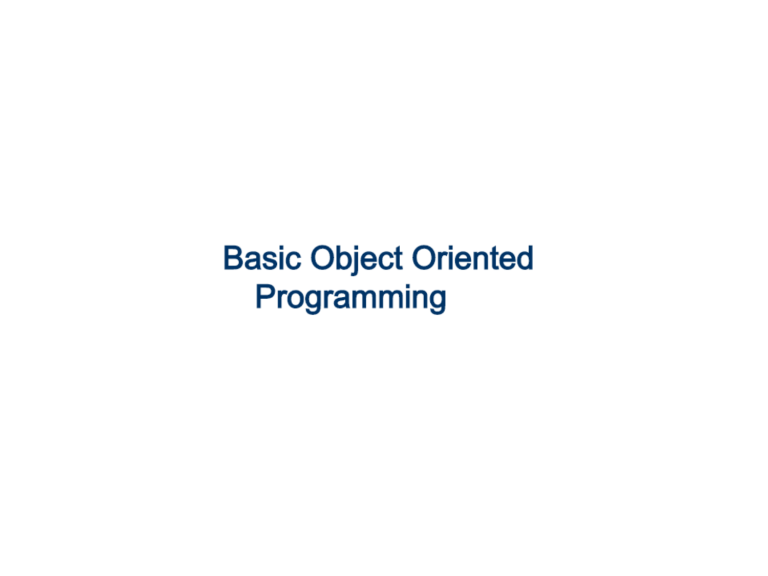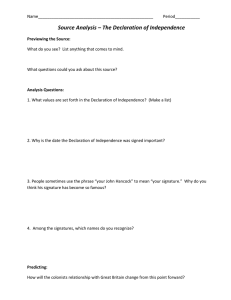
About Classes
• A class is a way to bind the data and its associated functions
together. It allows the data (and functions) to be hidden, if
necessary, from external use.
• When defining a class, we are creating a new abstract data
type that can be treated like any other built-in data type.
• Generally, a class specification has two parts:
1.
2.
Class declaration
Class function definitions
• The class declaration describes the type and scope of its
members.
• The class function definitions describe how the class
functions are implemented.
The general form of a class declaration is
Class Structure Explanation
•
•
•
•
The keyword class specifies, that what follows is an abstract data of type class_name.
The body of a class is enclosed within braces and terminated by a semicolon.
The class body contains the declaration of variables and functions.
These functions and variables are collectively called class members. They are usually
grouped under two sections:
1. private : can be accessed only from within the class.
– The use of the keyword private is optional. By default, the members of a class
are private.
– If both the labels are missing, then, by default, all the members are private. Such
a class is completely hidden from the outside world and does not serve any
purpose.
2. Public : can be accessed from outside the class also
• The keywords private and public are known as visibility labels.
• Note that these keywords are followed by a colon.
• The data hiding (using private declaration) is the key feature of object-oriented
programming.
Data Hiding In Classes
• The variables declared inside the
class are known as data members
and the functions are known as
member functions.
• Only the member functions can have
access to the private data members
and private functions.
• However, the public members (both
functions and data) can be accessed
from outside the class.
• This figure shows the binding of data
and functions together into a single
class-type variable is referred to as
encapsulation.
A Simple Class Example
Explanation
•
•
•
•
•
•
•
•
•
We usually give a class some meaningful name, such as item. This name now
becomes a new type identifier that can be used to declare instances of that class
type.
The class item contains two data members and two function members.
The data members are private by default while both the functions are public by
declaration.
The function getdata() can be used to assign values to the member variables
number and cost, and putdata() for displaying their values.
These functions provide the only access to the data members from outside the
class. This means that the data cannot be accessed by any function that is not a
member of the class item.
Note that the functions are declared, not defined. Actual function definitions will
appear later in the program.
The data members are usually
declared as private and the member functions as public.
Figure below shows two different notations used by the OOP analysts to represent
a class.
Representation of a class
Creating Objects
• Remember that the declaration of item as shown above does not
define any objects of item but only specifies what they will contain.
Method 1 of Object Creation
• Once a class has been declared, we can create variables of that type
by using the class name (like any other built-in type variable).
• For example,
item x; // memory for x is created
• creates a variable x of type item. In C++, the class variables are
known as objects. Therefore, x is called an object of type item.
• We may also declare more than one object in one statement.
• Example:
item x, y, z;
• The declaration of an object is similar to that of a variable of any
basic type.
• The necessary memory space is allocated to an object at this stage.
Note that class specification, like a structure, provides only a
template and does not create any memory space for the objects.
Creating Objects
Method 2 of Object Creation
• Objects can also be created when a class is defined by
placing their names immediately after the closing
brace, as we do in the case of structures.
• That is to say, the definition
class item
{
....
.....
.....
} x,y,z;
• would create the objects x, y and z of type item. This
practice is seldom followed because we would like
• to declare the objects close to the place where they are
used and not at the time of class definition.
Accessing Class Members
•
•
•
•
•
•
•
•
•
As pointed out earlier, the private data of a class can be accessed only through the
member functions of that class.
The main() cannot contain statements that access number and cost directly.
The following is the format for calling a member function:
object-name.function-name (actual-arguments);
For example, the function call statement
x.getdata(100,75.5);
is valid and assigns the value 100 to number and 75.5 to cost of the object x by
implementing the getdata() function.
The assignments occur in the actual function. Similarly, the statement
x.putdata();
would display the values of data members. Remember, a member function can be invoked
only by using an object (of the same class). The statement like
getdata(100,75.5);
has no meaning. Similarly, the statement
x.number = 100;
is also illegal. Although x is an object of the type item to which number belongs, the
number (declared private) can be accessed only through a member function and not by
the object directly.
Accessing Class Members
•
•
•
•
It may be recalled that objects communicate by sending and receiving messages.
This is achieved through the member functions. For example,
x.putdata();
sends a message to the object x requesting it to display its contents.
A variable declared as public can be accessed by the objects directly. Example:
DEFINING MEMBER FUNCTIONS
•
•
•
•
•
•
•
Member functions can be defined in two places:
1. Outside the class definition
2. Inside the class definition
It is obvious that, irrespective of the place of definition, the function should
perform the same task.
1. Outside the Class Definition
Member functions that are declared inside a class have to be defined separately
outside the class.
Their definitions are very much like the normal functions. They should have a
function header and a function body.
An important difference between a member function and a normal function is that
a member function incorporates a membership ‘identity label’ in the header.
This ‘label’ tells the compiler which class the function belongs to.
The general form of a member function definition is
DEFINING MEMBER FUNCTIONS
1. Outside the Class Definition
• The membership label class-name :: tells the compiler that the function
function-name belongs to the class class-name.
• That is, the scope of the function is restricted to the class-name specified
in the header line. The symbol :: is called the scope resolution operator.
• For instance, consider the member functions getdata() and putdata() as
discussed above. They may be coded as follows:
DEFINING MEMBER FUNCTIONS
1. Outside the Class Definition
• Since these functions do not return any value, their return-type is void.
• The member functions have some special characteristics that are often
used in the program development.
• These characteristics are:
1. Several different classes can use the same function name. The
‘membership label’ will resolve their scope.
2. Member functions can access the private data of the class. A nonmember
function cannot do so. (However, an exception to this rule is a friend
function discussed later.)
3. A member function can call another member function directly, without
using the dot operator.
DEFINING MEMBER FUNCTIONS
1. Inside the Class Definition
• Another method of defining a member function is to replace the function
declaration by the actual function definition inside the class.
• For example, we could define the item class as follows:
When a function is defined inside a class, it is treated as an inline function. Therefore,
all the restrictions and limitations that apply to an inline function are also applicable
here. Normally, only small functions are defined inside the class definition.
MAKING AN OUTSIDE FUNCTION INLINE
• One of the objectives of OOP is to separate the details of implementation
from the class definition.
• It is therefore good practice to define the member functions outside the
class.
• We can define a member function outside the class definition and still
make it inline by just using the qualifier inline in the header line of
function definition. Example:
STATIC DATA MEMBERS
• A data member of a class can be qualified as static. The properties of a
static member variable are
• similar to that of a C static variable. A static member variable has certain
special characteristics.
• These are the following:
1. It is initialized to zero when the first object of its class is created. No
other initialization is permitted.
2. Only one copy of that member is created for the entire class and is
shared by all the objects of that class, no matter how many objects are
created.
3. It is visible only within the class, but its lifetime is the entire program.
• Static variables are normally used to maintain values common to the
entire class. For example, a static data member can be used as a counter
that records the occurrences of all the objects.
The use of a static data member
Explanation
• Note that the type and scope of each static member variable must be
defined outside the class definition.
• This is necessary because the static data members are stored separately
rather than as a part of an object.
• Since they are associated with the class itself rather than with any class
object, they are also known as class variables.
• The static variable count is initialized to zero when the objects are created.
• The count is incremented whenever the data is read into an object. Since
the data is read into objects three times, the variable count is incremented
three times. Because there is only one copy of count shared by all the three
objects, all the three output statements cause the value 3 to be displayed.
Sharing of a static data member
•
•
Static variables are like non-inline member functions as they are declared in a class
declaration and defined in the source file.
While defining a static variable, some initial value can also be assigned to the
variable. For instance, the following definition gives count the initial value 10.
int item :: count = 10;


